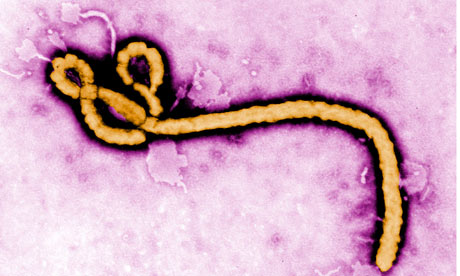Ebola: the solution may be in sight
Research in the US suggests that treatment against the deadly Ebola virus may be less than a decade away

One of the world's most feared pathogens, the Ebola virus, has a key structural weakness that could be vital in developing drugs to treat the fevers it triggers, US researchers announced in Nature last week. The group say they have bred mice that produce low levels of a protein known as Niemann-Pick C1 which transports cholesterol inside cells. The mice then survived exposure to Ebola, which causes a haemorrhagic fever, and to a cousin pathogen, the Marburg virus.
"This research identifies a critical cellular protein that the Ebola virus needs to cause infection and disease," said one of the lead scientists in the project, Sean Whelan of Harvard Medical School. "It also improves chances that drugs can be developed that directly combat Ebola infections," he said.
Ebola fever was first detected by doctors in the 1970s in villages along the Ebola river in the Democratic Republic of Congo and is usually fatal in humans. There have been at least two dozen Ebola outbreaks in Africa though doctors still do not know exactly how the virus is spread. There are no vaccines or drugs to fight it.
The virus is known to interfere with the cells that line the interior surfaces of blood vessels and with the process of blood coagulation. As a result, it causes blood vessel walls to become damaged and to rupture.
The new research announced at Harvard is therefore extremely important. It indicates that the protein Niemann-Pick is used by the Ebola virus to get deep inside cells. "This virus needs this protein," said Kartik Chandran, of Albert Einstein College of Medicine in New York. "Mice that have less of this protein are very resistant to being killed by Ebola and the Marburg virus."
Crucially, Chandran has also been involved in work that led to the discovery, in 2005, of a compound that has demonstrated considerable promise in being able to block the Niemann-Pick protein in human cells, according to a separate paper that was published in Nature last week. "Essentially, this compound can block infection by the virus," said Chandran.
The compound has not yet been tested in mice, and would still need to show it is effective in non-human primates. Chandran said blocking Niemann-Pick in the long term would probably cause illness.
The researchers involved in the studies say they are very optimistic that the new understanding they have built up about the behaviour of the Ebola virus and the means by which it gets into cells may eventually lead to treatments. However, they acknowledge it will take many years, and possibly even a decade of further research and studies, before treatments would be available for human use.

No comments:
Post a Comment